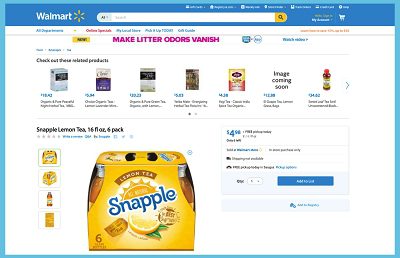Recognizing the importance of having complete, accurate, up-to-date digital content for all the products it sells, Walmart is seeking to “build a global product catalog of all the products that can be potentially transacted within the Walmart ecosystem,” according to Ram Rampalli, the retailer’s Global Head of Content Acquisition. “Whatever we sell, we want to make sure that all the products are represented online.”
Gathering product information for millions of SKUs and hosting it on Walmart.com represents a gigantic undertaking. For Rampalli, who in 2011 joined @WalmartLabs, the retailer’s technology support and innovation lab, the challenges boiled down to:
• Sourcing quality product content for so many products across thousands of suppliers; and
• Organizing, standardizing, and optimizing all that data to rapidly go live on the Walmart site.
Advertisement
Previously Walmart had been getting this product data from multiple sources, including brand partners, third-party catalog vendors, content pools and content service providers. But this approach was not sustainable or scalable. By partnering with Salsify, Walmart was able to develop “a seamless API that connects us to the supplier,” said Rampalli. “Then Salsify gets all the content, standardizes it, normalizes it and then pushes it to us.” The combination allows brands to get their product content live on the Walmart.com site in seconds rather than weeks or months.
Walmart’s efforts to enhance its product data collection and curation coincided with a desire by the Dr Pepper Snapple Group to capitalize on new digital growth opportunities. The CPG company’s web sites are not used for direct-to-consumer sales, but as brand messaging and awareness vehicles. Using a solution from Salsify, Dr Pepper Snapple Group was one of the first brands to leverage the Walmart.com API, and they are now delivering product content for more than 900 SKUs to the retailer.
Rampalli’s goals are to simplify the entire content management process for Walmart and for all of its suppliers. “If you are a Dr Pepper, you basically engage one of the Content Service Providers (CSPs) such as Salsify,” he explained in an interview with Retail TouchPoints. “You go to Salsify and say ‘This is my complete portfolio of 10,000 products. These 9,000 can be sold anywhere. These 1,000 are my private label. These are for Walmart, these are for another retailer, whatever the thing is.’
“Once they give that file to the CSP, they then are the central management point for the entire process, syndicating it to all the different retailers, pushing it here, pushing it there,” Rampalli added. “Everything is a full item setup. Everything can be controlled by the brands through the CSP. That is the ultimate vision.”
Online Content For In-Store Merchandise
Walmart kicked off this process in 2015 with a focus on Store Assortment Only (SAO) items. The retailer wanted to ensure that consumers who consult their mobile phones while shopping in a Walmart store would easily be able to discover the products they were looking for.
Greater product data consistency brings benefits to the brands as well as retailers and consumers. On Dr Pepper branded sites, for example, the supplier can completely control the look of its products. However, on partner retailer sites, the brand’s e-Commerce team has identified inaccuracies and gaps in how its portfolio was showing up. Retailers funneling data from multiple sources, third-party groups and legacy sales systems was resulting in the wrong brand experience, and in some cases the wrong information, for consumers.
“When shoppers walk into the store and see our brand, it’s exactly how our brand team, our packaging team, our marketing organization and our sales organization has worked to present it,” said Jordan Ste. Marie, Senior Manager, Ecommerce Marketing for Dr Pepper Snapple Group in a statement. Dr Pepper wanted to present its products with the same level of brand consistency online: “If we didn’t control with that same level of attention to detail online, it was going to lead to a poor shopper experience,” said Ste. Marie. “The more we dug into the online retailer landscape, it was clear bad data was a problem across every retailer — not just one.”
Faced with its own daunting task, the Dr Pepper team prioritized key retailers, including Walmart. Like the retailer, the CPG brand realized early on that its current manual processes would not be sufficient for rapidly expanding digital demands. Dr Pepper implemented the Salsify Product Content Management platform in June 2015.
“We can share the data with all of our retail partners and anybody else that is displaying our product content online, and we know and trust that it is brand-approved, legal-approved, and has all of our most up-to-date packaging,” said Ste. Marie.
Next Steps: Rich Media And Multiple Channels
Walmart has integrated “more than a couple of thousand brands in the new API at this point,” said Rampalli. “We are continuously adding at least a 150 to 200 brands week over week.”
In addition to sheer volume, Rampalli and his team are seeking ways to collect, organize and display a wider range of content types. “We started off with existing items’ content enrichment; our next step is to add the ability to upload rich media,” he said. “After that comes the full item specification/complete item setup. Then the item setup across multiple channels, whether it is a marketplace item or one store.”









